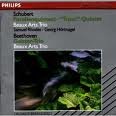| All Artists: Schubert, Beethoven, Beaux Arts Trio Title: Trout Quintet / Ghost Trio Members Wishing: 0 Total Copies: 0 Label: Polygram Records Release Date: 10/25/1990 Genre: Classical Styles: Chamber Music, Historical Periods, Classical (c.1770-1830) Number of Discs: 1 SwapaCD Credits: 1 UPC: 028942071629 |
Search - Schubert, Beethoven, Beaux Arts Trio :: Trout Quintet / Ghost Trio
CD Details |
CD ReviewsAn expansive but muscular "Trout" Discophage | France | 10/13/2006 (4 out of 5 stars) "There is a longstanding association between the Beaux-Arts Trio and Schubert's "Trout" quintet which, paradoxically, predates even the official establishment of the ensemble in 1955 by violinist Daniel Guilet, cellist Bernard Greenhouse and pianist Menahem Pressler: in 1954 the MGM label published (on LP of course) a recording - which alas is unreissued as of today, and which I haven't heard - by Pressler and the "Guilet Quartet". The one documented on this CD was recorded in 1975 - the same year as the one by Gilels and the Amadeus Quartet on DG (see my review). The trio appears in its later line-up with violinist Isidore Cohen, who replaced Guilet upon the latter's retirement in 1966, and is joined by violist Samuel Rhodes and bassist Georg Hortnägel (who, like Aloys Posch or Julius Levine, must have recorded more "Trouts" than one can count). It is a good reading, characterized by expansive tempos and muscular phrasings, but also a somewhat dry tonal production and a slightly over-exposed piano.
The tempo in the opening "Allegro vivace" (played with its repeat) is leisurely - it is indeed the most expansive reading among the twenty or some I have heard - but the movement gives no impression of plodding thanks to muscular and well-accented phrasings. The piano is favored by the recording pickup and sounds a bit crude and glaring (especially when heard directly after Indrid Haebler's marvelously cristalline playing with the Grumiaux trio in 1966, also on Philips), and though Isidore Cohen's violin displays plenty of lyricism and charm, his partners' tonal production lacks a touch of bloom, with sparse pedalling from Menahem Pressler and a rather dry cello tone from Bernard Greenhouse in the lyrical cello and violin dialogue starting at 1:55. Taken at a forward-moving tempo (but not as briskly as Archibudelli or Ax-Ma and friends - both on Sony - or Paul Badura-Skoda on the two recordings documented on the Amiata label: see my reviews), the ensuing "Andante" (2nd movement) is quite effective, although the Beaux Arts lack a true pianissimo at the end of the movement's two sections (the second section repeats the first in another key) and don't command the sense of hushed mystery elicited by others; instead, at their hands the passage rather suggests (to me) the opening scene of Rossini's "Barber of Seville", when count Almaviva sneaks near Rosina's window whispering to his fellow serenade players "zitto zitto". As in the first movement, violist Samuel Rhodes and Bernard Greenhouse do not elicit the warmest of tones in the moving cantilena starting at 1:22, but that very dryness, along with the forward-moving tempo, imparts it a kind of wistful, "Jewish" tinge reminiscent of the trio section in the 3rd movement of Mahler's 1st symphony - an interesting effect already encountered in the 1958 recording of Hepzibah Menuhin and the Amadeus Quartet (EMI). The Scherzo is sprightly and strongly accented, with a relaxation of tempo in the middle trio which somewhat stifles forward momentum, though Menahem Pressler's piano is full of snap. Again in the 4th movement's theme and variations, the piano's forward-placement is a notable and slightly disturbing feature. The ensemble shapes the movement as a slow-fast-slow architecture: they take the theme and first two variations at a leisurely pace, then give a marked fillip to tempo in the third (lively and dynamic) and fourth (powerful and assertive) variations, only to markedly slow down again and adopt an unusually deliberate pace for the fifth, which in turn leads them to an unhurried but finely accented coda, with snappy articulation and charm aplenty. The Finale ends in the same unhurried, expansive mood: after their fishing outskirt in the countryside our five partners are obviously happy to stroll leisurely back to Vienna and muse along. No criticism intended - this is a perfectly valid and musical option. This CD reissue, paired with the Beaux Arts' muscular and dynamic reading of Beethoven's "Geister"-trio from 1980 (the ensemble's second recording), was published by Philips as early as 1987 and further reissued in 1992 on the label's Insignia collection (with an asinine photo of the Beaux Arts Trio's later line-up with cellist Peter Wiley). The "Trout" can now be found in SACD-form on the Pentatone label with Mozart's Clarinet Quintet recorded by Georg Pieterson and the Grumiaux quartet in 1974, while the Beethoven is now collected on a 5-CD box with the Beaux-Arts Trio's second traversal of Beethoven's complete trios. " |

